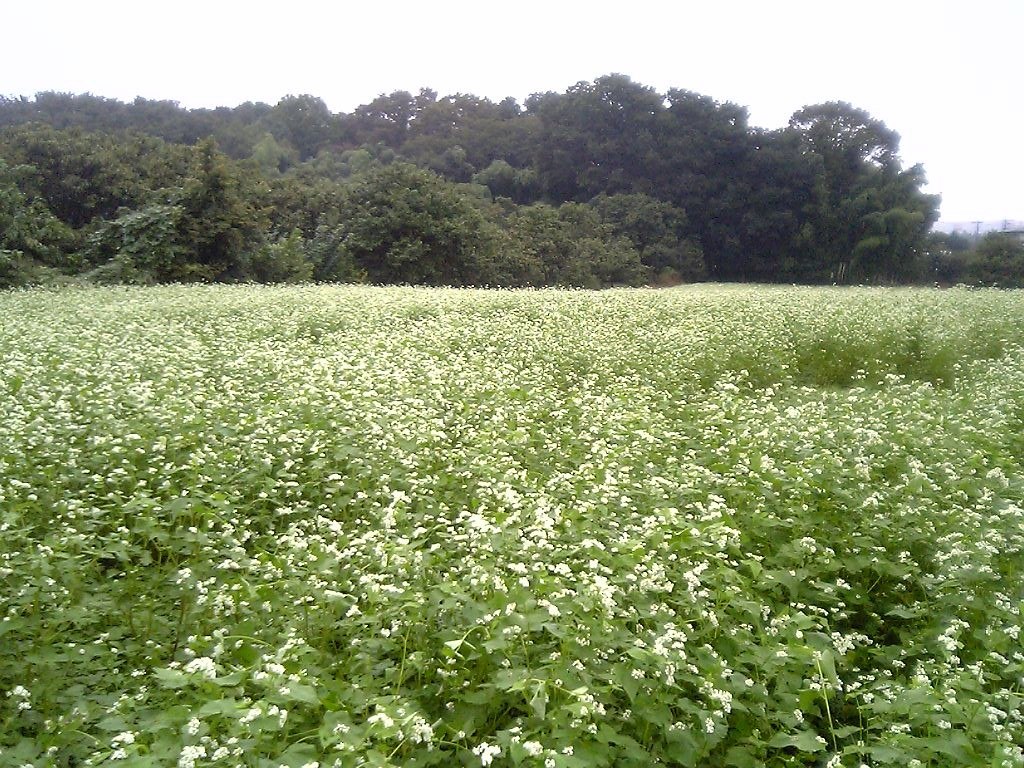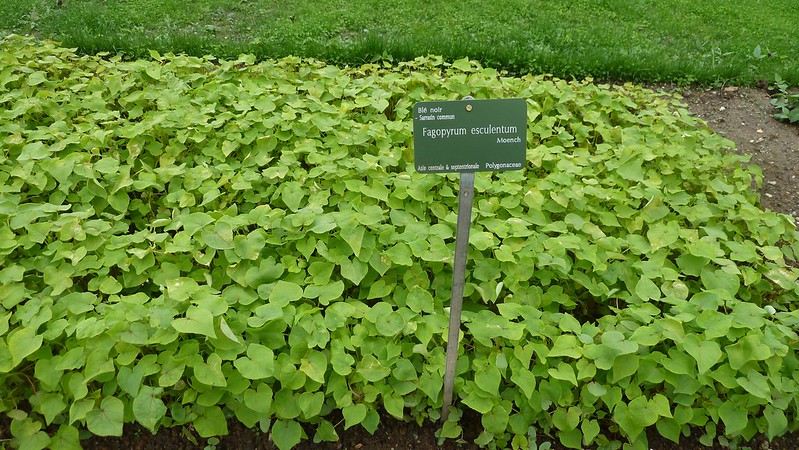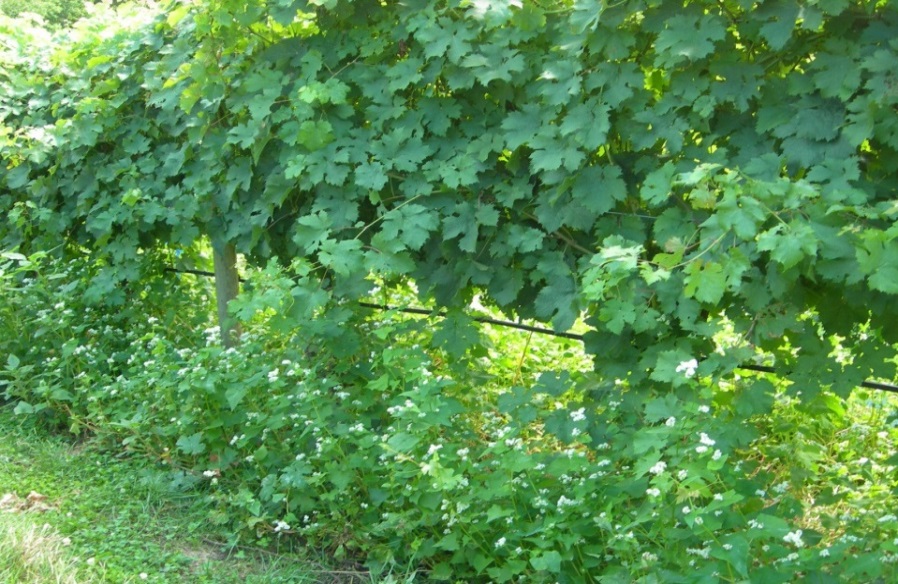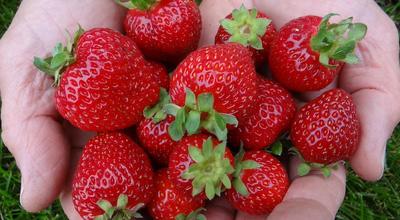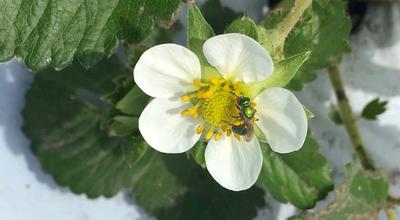Previous post in this series: Vineyard cover crops, part 1: An overview
In this Vineyard Cover Crops series, we’re evaluating three under-vine cover crop species for use in Minnesota vineyards. This week we’re taking a look at buckwheat, and how its use as a cover crop affects various aspects of a vineyard.
Buckwheat effects on grape quality
Buckwheat has very few effects on the wine quality when other conditions are controlled. In a two year study buckwheat was observed to have no significant effect on the brix, acidity, or quality of the grape must or wine (Jordan 2014). Despite having no significant effect on wine quality, a buckwheat cover crop can have a variety of effects on the vineyard site, which could help in managing the land.
Buckwheat effects on vineyard temperatures
In order to avoid completely re-sowing buckwheat each year, growers need to wait at least 5-7 weeks for the crop to seed prior to mowing (Bjorkman et al. 2008). After that point, buckwheat could be up to 3 feet tall and might hinder airflow (Oplinger et al. 1989), which could cause cool air to pool and increase the frost risk (Bugg et al. 1975). Also during this period of maturity, buckwheat has a direct cooling effect in the vineyard due to its high evapotranspiration rate (Yan et al. 2015), and the shade that its broad leaves provide.
These issues would not have any negative consequences in the vineyard, as long as regular mowing occurred in the spring and fall to reduce the frost risk. During the warmer months of summer when buckwheat would be allowed to flower and go to seed, the grape berries are in the lag stage of development, and demand less heat and water (Hardie and Considine 1976; Lecourieux et al. 2017).
Buckwheat interactions with soil nutrients and water
Over much of the viticultural land in southern and western Minnesota, a thick layer of fertile soil with high water holding capacity is the product of the prairies that once covered much of the state (Anderson et al. 2018). In these areas, buckwheat is an effective nutrient scavenger, using some nutrients that could contribute to excessive vigor during the growing season (Filippetti et al. 2013), while also improving availability of other important nutrients in the soil.
Many Minnesota soils are not only fertile, but also have a high water holding capacity (Anderson et al. 2018). This factor along with Minnesota’s heavy precipitation during the growing season, can lead to excessive vigor in the vines as well (Williams 2003). Though mature buckwheat does have a high rate of evapotranspiration (Yan et al. 2015), which reduces the soil water content, it has been found to be a weak competitor against vines for water (Jordan 2014). In short, though buckwheat removes excess nutrients and water from the soil, it will likely not do so to an extent that negatively affects the vines.
Buckwheat vs. weeds
Buckwheat is an effective weed suppressing cover crop, and performs well in established vineyards. When seeded after the risk of frost is past, buckwheat establishes quickly. Broad leaves and a dense growth habit allow buckwheat to smother weeds by outcompeting them for light and space (Bistline-East et al. 2016; Weigle and Carroll 2016). Additionally, buckwheat secretes allelopathic hormones into the soil which suppress the growth of other seedlings and young plants (Tominaga and Uezu 1995; Golisz et al. 2007). On established vineyards that are struggling to suppress weeds growing under the vine, buckwheat may be one of the best options.
Buckwheat effect on erosion control
The vine canopy itself shields the ground under it from raindrop impact, so slowing runoff and holding the soil together are the benefits we look for in an under-vine cover crop. Unlike some grasses and legumes, buckwheat does not form a thick mat over the soil surface, and does not have a very dense root structure (Bjorkman et al. n.d.; Bugg et al. 1975). For these reasons it is less effective at controlling erosion. However, any cover crop will help increase soil conservation over leaving the soil bare (Bugg et al. 1975; Weigle and Carroll 2016).
Buckwheat interactions with pests and diseases
When choosing a cover crop to play a role in a vineyard’s integrated pest management, buckwheat has benefits and potential drawbacks. In studies, buckwheat has increased predatory insect populations for many common vineyard pests (Bistline-East et al. 2016); however, many of these pests are not yet primary concerns in Minnesota. Also, using buckwheat instead of grass cover crops such as fescues, prevents the formation of a sod layer, which is known to host vineyard pests such as Japanese Beetles and Rose Chafers (Hoover et al. 2011).
Minnesota’s humid climate is ideal for fungal diseases, but studies conducted in other humid climates suggest that under-vine mulching reduces the risk of fungal diseases on berry clusters (Mundy and Agnew 2002; Jacometti et al. 2007). Since buckwheat grows aggressively through the season and needs regular mowing (Oplinger et al. 1989), the mulch from its cutting would likely help to reduce fungal disease pressure. It’s important to note that these studies were conducted in areas with milder climates. In Minnesota, severe winter temperatures result in regular winter injury, and a thick layer of mulch near a damaged trunk could represent a serious disease risk. Mulching effects in cold climates require more research to provide more accurate information.
Stay tuned for our next article in this series, Vineyard cover crops, part 3: White clover.
Works Cited
Anderson, J., J. Bell, T. Cooper, and D. Grigal. 2018. Soil Orders and Suborders in Minnesota. University of Minnesota Extension. https://extension.umn.edu/soil-management-and-health/soil-orders-and-suborders-minnesota
Bistline-East, A., N.A. Irvin, and M.S. Hoddle. 2016. The Effect of an Irrigated Buckwheat Cover Crop on Grape Vine Productivity, and Beneficial Insect and Grape Pest Abundance in Southern California. Biological Control. https://www.sciencedirect.com/science/article/abs/pii/S1049964415300530
Bjorkman, T., R. Bellinder, R. Hahn, and J. Shail. 2008. Buckwheat Cover Crop Handbook. http://www.hort.cornell.edu/bjorkman/lab/covercrops/pdf/bwbrochure.pdf
Bugg, R.L. et al. 1975. Cover Cropping in Vineyards. University of California Cooperative Extension. http://cecentralsierra.ucanr.edu/files/96232.pdf
Filippetti, I. et al. 2013. Influence of Vigour on Vine Performance and Berry Composition of Cv. Sangiovese (Vitis vinifera L.). Journal International des Sciences de la Vigne et du Vin. https://www.researchgate.net/publication/258627589_Influence_of_vigour_on_vine_
performance_and_berry_composition_of_cv_Sangiovese_Vitis_vinifera_L
Golisz, A., B. Lata, S. W. Gawronski, and Y. Fujii. 2007. Specific and Total Activities of the Allelochemicals Identified in Buckwheat. Weed Biology and Management. https://doi.org/10.1111/j.1445-6664.2007.00252.x
Hardie, W.J., and J.A. Considine. 1976. Response of Grapes To Water-Deficit Stress in Particular Stages of Development. American Journal of Enology and Viticulture. https://www.ajevonline.org/content/27/2/55
Hoover, Emily E., S. Wold-Burkness, J. Hilton, D. Mollov, E. Burkness, T. Galvan, P. Hemstad, and W.D. Hutchinson. 2011. Grape IPM Guide for Minnesota Producers. University of Minnesota Digital Conservancy. http://hdl.handle.net/11299/166875
Jacometti, M.A., S.D. Wratten, and M. Walter. 2007. Enhancing Ecosystem Services in Vineyards: Using Cover Crops to Decrease Botrytis Bunch Rot Severity. International Journal of Agricultural Sustainability. https://doi.org/10.1080/14735903.2007.9684830
Jordan, L.M. 2014. Evaluating The Effects of Using Annually Established Under-Vine Cover Crops in Northeastern Riesling Vineyards. MS Thesis Cornell Univ. Ithaca NY. https://ecommons.cornell.edu/handle/1813/38865
Lecourieux, F. et al. 2017. Dissecting the Biochemical and Transcriptomic Effects of a Locally Applied Heat Treatment on Developing Cabernet Sauvignon Grape Berries. Frontiers in Plant Science. https://pubmed.ncbi.nlm.nih.gov/28197155/
Mundy, D.C., and R.H. Agnew. 2002. Effects of Mulching with Vineyard and Winery Waste on Soil Fungi and Botrytis Bunch Rot in Marlborough Vineyards. New Zealand Plant Protection. https://pdfs.semanticscholar.org/3aed/748f9e114757c02ef2c61c54dcf5085f0e8c.pdf
Oplinger, E.S., E.A. Oelke, M.A. Brinkman, and K.A. Kelling. 1989. Buckwheat. Alternative Field Crops Manual. https://hort.purdue.edu/newcrop/afcm/buckwheat.html
Tominaga, T. and T. Uezu. 1995. Weed Suppression by Buckwheat. Current Advances in Buckwheat Research. http://citeseerx.ist.psu.edu/viewdoc/downloaddoi=10.1.1.613.9499&rep=rep1&type=pdf
Weigle, T. and J. Carroll, eds. 2016. Organic Production and IPM Guide for Grapes. New York State Integrated Pest Management Program. Ithaca, NY. https://hdl.handle.net/1813/42888
Williams, L. E. 2000. Grapevine Water Relations. Raisin Production Manual. (Ed. LP Christensen) pp, 121-126. http://iv.ucdavis.edu/files/24436.pdf
Yan, H. et al. 2015. Study of Evapotranspiration and Evaporation beneath the Canopy in a Buckwheat Field. Theoretical and Applied Climatology.
https://link.springer.com/article/10.1007/s00704-014-1325-6
Acknowledgements
Jayden Corliss is a graduating CFANS student contributing these articles for credit as a distance learning substitute for a field course. Jayden is an assistant winemaker at North Shore Winery.
Thanks to Dr. Emily Hoover and Emily Tepe for their contributions to this article.

